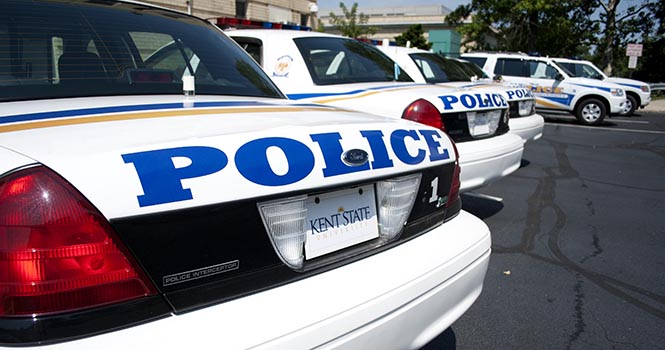Kent State’s emergency plan still fit for all crises
November 18, 2015
The recent terrorist attacks in Paris have put the whole world on edge about safety. The Emergency Management Plan at Kent State is designed to prepare all of Kent’s campuses for extreme crises.
In the (KSU-EMP), an emergency is defined as any event or condition that presents an imminent risk of death, serious injury or illness to the university community, suspension or significant disruption of university operations, significant physical or environmental damage, or a significant threat to the university’s financial well‐being.
“We have an EMP in place that will adapt to any situation that could arise at Kent State,” said Tricia Knoles, a community resource officer at the KSUPD. “It continually gets revised and updated. Our police officers train monthly and take our training very seriously because our main goal is to keep our community safe.”
Of the six emergency situations defined in the KSU-EMP, two are regarding terrorist incidents and active shooters.
The KSU-EMP defines three different levels of emergencies depending on the severity, with level one being a major disaster, level two being a major incident or potential threat and level three being a minor, localized incident. In all cases of emergency, students and faculty remain a priority.
“The ultimate goal is people’s safety,” said Kent State Police Officer Jeff Futo.
He said that once safety is assured, the university property becomes a priority.
This plan is set up to be extremely broad, according to Futo, who is also a safety and emergency specialist. This is because no two emergencies are the same. He said the plan was meant to have more of a broad layout, giving administration guidance and direction in times of emergency.
“It doesn’t tell us exactly what to do. It gives us a guideline of what actions to take in emergency situations,” Futo said.
The president of the university is ultimately responsible for initiating a response to any threats or emergencies on campus, but the director of public safety is also able to implement the KSU-EMP in emergency situations.
“The plan is there to help us, as a university, for all types of emergencies,” said Futo.
Futo stated each individual building on campus has its own emergency response plan, alongside the KSU-EMP. These plans contain information regarding shelter, evacuation, building safety and how to keep students safe in each specific building. In times of emergency, students and faculty who may be in harm’s way will look to a more specific plan depending on which building they are in or near.
“The most important things for students to know and do during an emergency is to listen to any announcements that may be made over the mass notification system, which includes PA’s inside of dorms and buildings,” Knoles said.
The campus has many ways of notifying students and faculty of an emergency including outdoor sirens, indoor and outdoor speaker systems, alert monitor pager system, cable alerts, text alerts, mass emails, university website updates, print and broadcast media.
Regardless of the severity and whether they are indoor or outdoor, students will be notified of any possible threats on campus.
“I think that our school has a good system when it comes to alerting students of emergencies,” said Melissa Cirilo, a junior middle childhood education major.
Students are urged to sign up for Flash Alerts, which is Kent State’s official emergency text notification system that alerts students of any pending or current emergencies.
“I think Flash Alerts help because you know almost instantly if something is going on,” Cirilo said.
While the KSU-EMP is designed for the administration to be prepared for any type of emergency on campus, there is also an emergency guide for students, visitors, faculty and staff to follow. This emergency guide serves as a quick reference guide during pending or serious emergencies on campus.
The emergency guide contains information and guidance regarding building evacuations, shelter-in-place, campus evacuations, active shooter incidents, biological threats, bomb threats, chemical threats, fires, floods, natural disasters, explosives, pandemics and severe weather conditions.
Kent State has an online ThreatLine and phone number (330-672-SAFE), intended for students and faculty to report any suspicious activity or safety concerns on campus. However, it is preferred for students to call 911 if they are faced with an emergency.
Other safety measures include Alert, Lockdown, Information, Counter and Evacuation (A.L.I.CE.), which are training sessions available for students who want to prepare for crisis situations. These crisis-training sessions are held frequently and are designed to give participants common sense insight and response options when encountering an active shooter.
Carson Kleinman is the transportation/safety reporter for the Kent Stater. Contact her at [email protected].

























